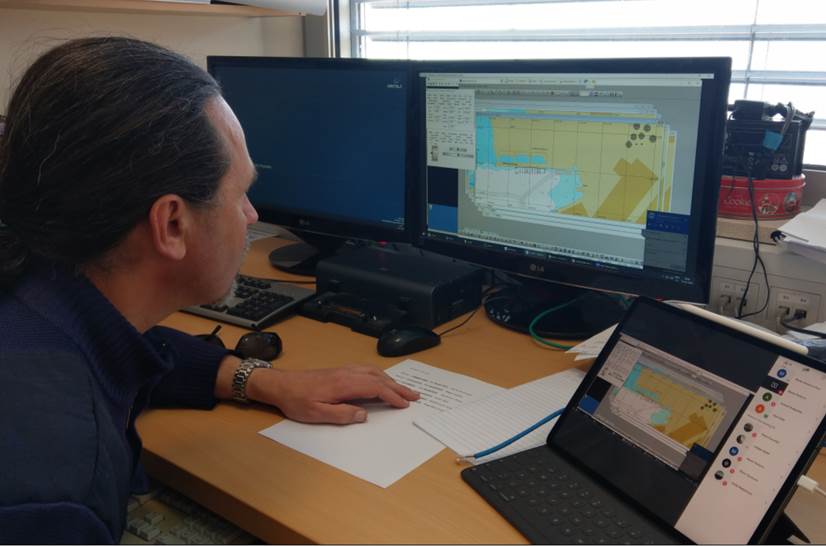

The expedited launch of Wärtsilä’s new cloud simulation platform has enabled seafarer schools to continue training despite the lockdowns and distancing imposed by the coronavirus outbreak.
“A remote service built remotely.” That’s how Johan Ekvall, Solutions & Business Development Director, Wärtsilä Voyage, describes the company’s new cloud simulation training platform, which was launched recently as much of the world was still coming to terms with the impact of the Covid-19 pandemic.
The new solution allows instructors to deliver simulation training courses to student seafarers studying at home and other remote locations. While Simulation Cloud Services had already largely been developed, it took a global health scare to accelerate the final stages of development.
“In three weeks we did things that would normally have taken us six months,” explains Ekvall. “We had to deploy a completely new platform. We adapted navigational simulation systems that were designed to be on ships for the cloud, and prepared a tool meant to work on just one certified operating system to run on whatever students have at home. It was a huge achievement by our research and development team.”
A concept with history
Although widespread lockdowns and social distancing provided the final impetus to bring cloud-based (or ‘distributed’) learning to seafarer education, the concept had been discussed for nearly a decade. Wärtsilä Voyage (then Transas) delivered its first remote training platform back in 2015 to the State University of New York’s Maritime College. But that was a simpler system in which students made their own way through a pre-defined course, rather than the interaction between student and instructor enabled by Wärtsilä Simulation Cloud Services.
“The beauty of online classes is that the instructor takes their existing content and runs the course in almost the same way,” says Ekvall. “Instructors can run the course from day one using their existing databases, models and exercise areas. Our technical challenge is to make that experience as good or better than the classroom, even when students have one screen instead of the multiple screens they may have in a classroom.”

According to one of the schools that helped Wärtsilä Voyage to test the new service, the ability to teach students from afar has been critical in a period that could have been hugely disruptive. When the Slovenian government put in place social distancing recommendations in response to the coronavirus outbreak in March, the maritime department at the University of Ljubljana closed for a couple of days to consider how to proceed.
The faculty, including head of department Dr Andrej Androjna, was aware that the recommendations would severely limit the practical training it could offer students. But a delay in the education of future seafarers would have a big knock-on impact on recruitment, as well as posing difficulties for the students themselves.
The proposal from Wärtsilä Voyage was very welcome, says Dr Androjna. “We have established good relations with Wärtsilä Voyage over the years, including testing newly developed models and simulator integrations. Back in 2005, we contributed to the integration of their nautical communications, vessel traffic system, and oil spill simulators, and we have since contributed to the development of common training scenarios.”
Immediate implementation
The University of Ljubljana quickly saw the potential in Wärtsilä Voyage’s Cloud Solutions offering, deploying it across six-course modules, including ECDIS training, main engine propulsion and passage planning. These month-long courses, taught to students studying both naval architecture and marine engineering degrees, would have been severely restricted without the capability to offer them remotely.
“The cloud courses were a perfect solution to the problem of Covid-19,” says Dr Androjna. “We liked that the simulator preparation and choice of configuration are enabled and performed in the same way as in the actual simulator and that students can repeat the exercises without the presence of the instructor. We also noticed that students are much more relaxed and actually communicate more.”
As with any trial of a new service, there was constructive feedback. The debriefing process in a classroom is challenging to replicate, where the task is normally analysed with the help of physical tools – including active tables and marker pens for noting important elements on the exercise record. In a real classroom, students can also switch between workplace sites resembling stations on the bridge. But Dr Androjna is convinced that Wärtsilä will be able to improve these elements.
“Simulation Cloud Services will give students a laboratory to learn in wherever they are,” he says. “It is the future. We are convinced of this and we are already testing a full mission simulation over the cloud using our own simulators at the school.”
Gaining certification
Wärtsilä Voyage took a big step towards advancing the uptake of cloud-based simulator training earlier this month, when classification society ClassNK certified online installations of its engine room and liquid cargo and ballast handling simulators. This makes Wärtsilä Voyage’s new offering the world’s first class-approved cloud-based simulator based on STCW training requirements.
Naoki Saito, General Manager, Maritime Education and Training Certification Department, ClassNK, explains that the certification will help Wärtsilä and its partners to bring more seafarer recruits into the market. “Nowadays, the training needs digitalization to attract trainees and we would like to support the training providers, together with Wärtsilä, to contribute to safe navigation,” he says.
For Wärtsilä Voyage, there are some key moves to expand and improve the Cloud Simulation platform, explains Neil Bennett, Sales Director, Global Simulation.
“Our next steps are to maximise automation of the management of cloud infrastructure, which will allow us to handle more customers. But the key point we are working towards is a single platform allowing for all simulation training platforms – be that traditional classroom, cloud-based or even virtual and augmented realities. Then all the investment in modelling, interface and content can be put into one version rather than replicated for each medium.”
According to Bennett, feedback from schools like the University of Ljubljana indicate not only a willingness to try new solutions during a period of disruption, but a wider and more far-reaching change in attitude to seafarer training.
“Several schools have commented on how proud and impressed they are with their team members, who have gone, almost overnight, from classroom learning to taking courses online,” he says. “Our users have seen that Simulation Cloud Services will be needed in the future, and the current situation has only accelerated the adoption. I think this new service will pave the way for permanent changes in the way maritime training is delivered.”
For more information on the solution, please contact us at wv.marketing@wartsila.com.
Related solutions
Did you like this? Subscribe to Insights updates!
Once every six weeks, you will get the top picks – the latest and the greatest pieces – from this Insights channel by email.

-(1)-min.tmb-424x424.jpg?Status=Master&Culture=en&sfvrsn=e90cae44_1)

